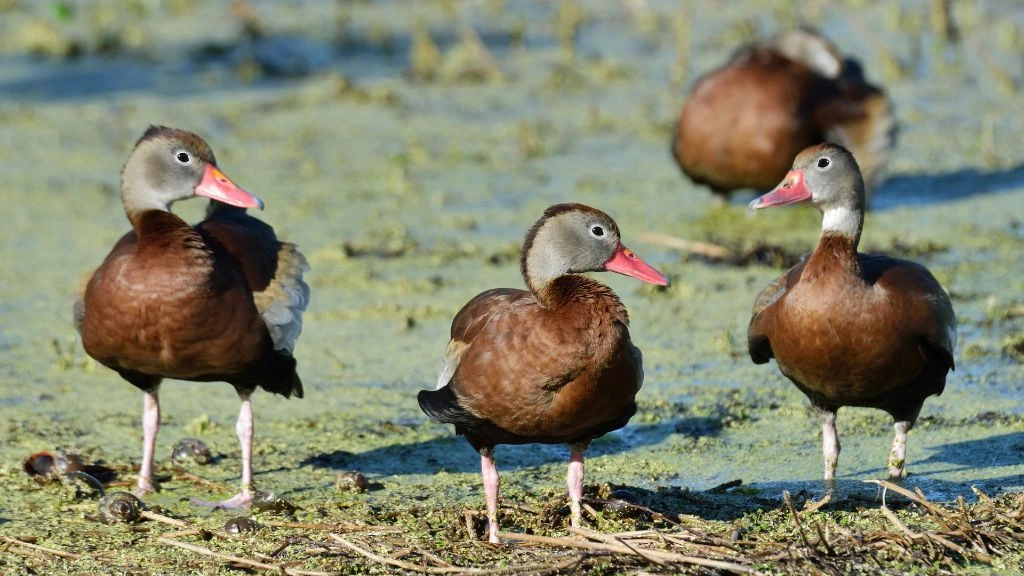Florida, known for its stunning beaches and vibrant wildlife, is a paradise for birdwatchers. With its diverse ecosystems ranging from subtropical wetlands to coastal estuaries, the state hosts a remarkable array of bird species. Among these, ducks stand out not only for their variety but also for their beauty and unique behaviors. Whether you are an avid birder or a casual nature enthusiast, exploring the ducks of Florida offers an enriching experience.
In this guide, we will take a closer look at some of the most fascinating Types of Ducks in Florida, where to find them, and why they are important to the state’s ecosystem.
1. Mallard (Anas platyrhynchos)
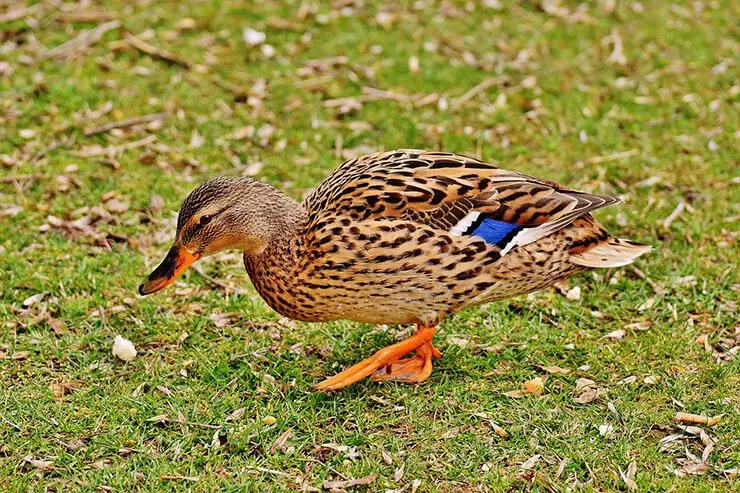
The Mallard is perhaps one of the most recognized duck species globally, and Florida is no exception. With their striking green heads, yellow beaks, and distinctive quack, Mallards are often the first ducks that people learn to identify.
Where to Find Them: Mallards are highly adaptable and can be found throughout Florida, from urban parks and ponds to rural wetlands. One of the best places to spot Mallards is the Fort De Soto Park, where they thrive in the park’s various water bodies.
Ecological Role: Mallards are essential for maintaining the health of aquatic ecosystems. As dabbling ducks, they feed on aquatic plants, insects, and small fish, which helps to control overpopulation and maintain balance in the ecosystem.
Interesting Fact: Mallards are the ancestors of most domestic duck breeds, which means that the ducks you see on farms or in petting zoos often have Mallard lineage.
2. Ring-necked Duck (Aythya collaris)
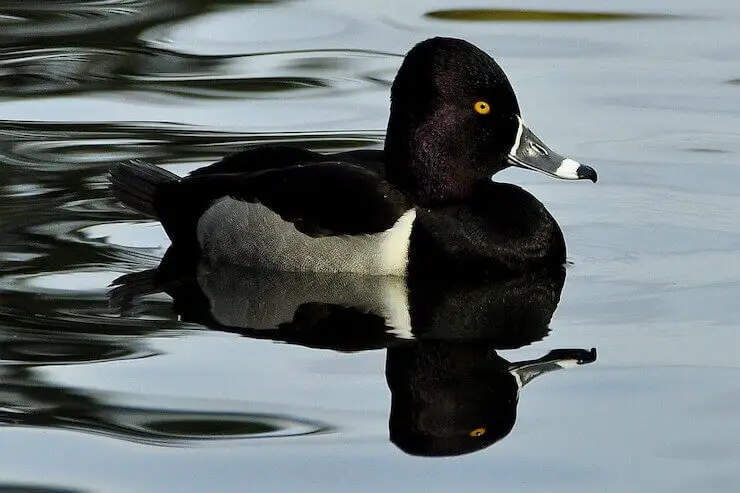
Despite its name, the ring around the neck of the Ring-necked Duck is quite subtle, making it challenging to spot. Instead, these ducks are easily identifiable by their sharp black and white coloring and the distinctive peaked head shape of the males.
Where to Find Them: Ring-necked Ducks are winter visitors in Florida, often seen in large numbers in freshwater lakes and ponds. Merritt Island National Wildlife Refuge is a prime location to see these ducks, especially during the cooler months.
Ecological Role: These diving ducks play a crucial role in controlling aquatic invertebrate populations. By feeding on insects, snails, and small crustaceans, they help maintain the health and diversity of aquatic habitats.
Interesting Fact: Ring-necked Ducks are known for their unique ability to take flight without the typical running start that many other duck species require.
3. Ruddy Duck (Oxyura jamaicensis)
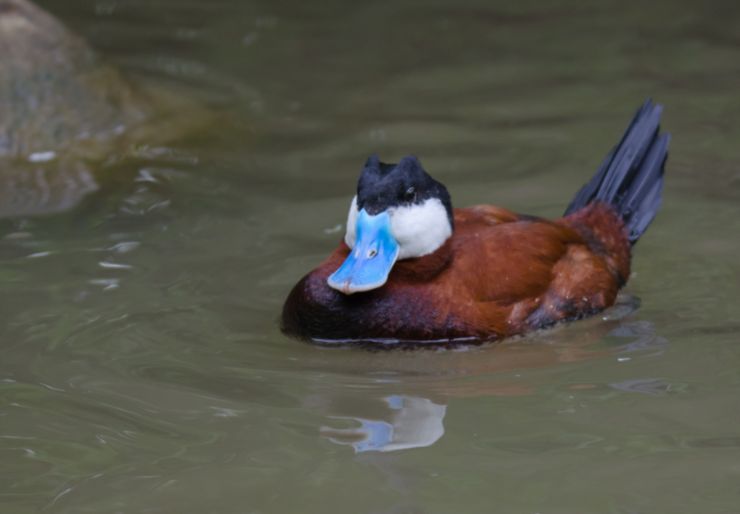
Ruddy Ducks are small, stout diving ducks known for their bright blue bills and stiff-tailed appearance. Males have a striking chestnut body and a white face, while females are more subdued in their brown and grey coloring.
Where to Find Them: These ducks are more commonly seen during the winter months in Florida, especially in the Everglades National Park, where they gather in the shallow waters.
Ecological Role: As diving ducks, Ruddy Ducks help control the populations of aquatic plants and animals, contributing to the health of their ecosystems.
Interesting Fact: Ruddy Ducks are known for their courtship displays, where males perform elaborate bubbling displays by blowing air bubbles underwater.
4. Mottled Duck (Anas fulvigula)
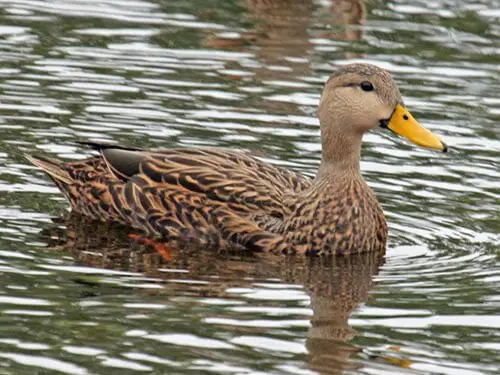
The Mottled Duck is a year-round resident of Florida, making it a favorite among local birdwatchers. These ducks resemble female Mallards but can be distinguished by their darker, more uniformly colored bodies.
Where to Find Them: Mottled Ducks are commonly found in wetlands and coastal marshes. The J.N. “Ding” Darling National Wildlife Refuge is an excellent spot to observe these ducks in their natural habitat.
Ecological Role: Mottled Ducks are important for seed dispersal in wetland environments, helping to propagate aquatic plants that are crucial for the ecosystem.
Interesting Fact: The Mottled Duck is one of the few duck species that are native to Florida, making it an important species for conservation efforts in the region.
5. Wood Duck (Aix sponsa)
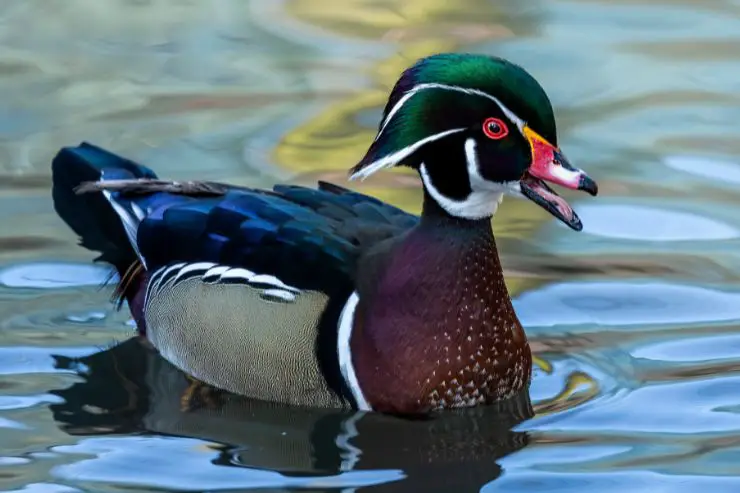
Known for their stunning iridescent plumage and distinctive call, Wood Ducks are among the most beautiful waterfowl in North America. Males are especially eye-catching with their colorful feathers, while females have a more muted, yet still elegant, appearance.
Where to Find Them: Wood Ducks prefer wooded swamps, ponds, and streams. Myakka River State Park is a popular spot to see these ducks, particularly in the spring and summer months.
Ecological Role: Wood Ducks play a significant role in forested wetland ecosystems. They feed on a variety of plant materials, insects, and small aquatic animals, thus contributing to the balance of these environments.
Interesting Fact: Wood Ducks are one of the few duck species that nest in tree cavities. They are known to use artificial nest boxes, which has helped their populations recover after a period of decline.
6. Northern Pintail (Anas acuta)
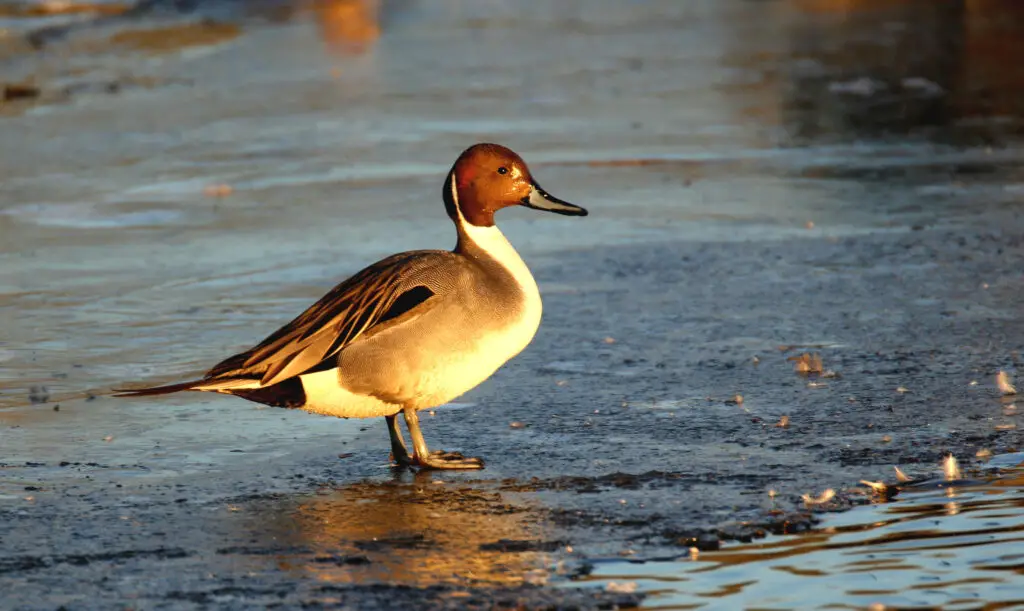
The Northern Pintail is an elegant and slender duck species, easily recognizable by the males’ long, pointed tails and sleek brown heads. Females are more cryptic in appearance but are equally graceful.
Where to Find Them: These ducks are winter visitors to Florida and can often be found in the state’s wetlands, estuaries, and salt marshes. Saint Marks National Wildlife Refuge is a prime location to spot Northern Pintails during the winter months.
Ecological Role: Northern Pintails are important for maintaining the health of wetland ecosystems. They feed on a variety of aquatic plants and seeds, which helps to control plant growth and maintain open water areas.
Interesting Fact: Northern Pintails are one of the most widely distributed duck species in the world, found across North America, Europe, and Asia.
7. Blue-winged Teal (Spatula discors)

With their distinctive blue wing patches and white facial crescent, Blue-winged Teals are a favorite among birdwatchers. These small, fast-flying ducks are often seen skimming low over the water.
Where to Find Them: Blue-winged Teals are abundant throughout Florida, especially during migration periods. They are frequently seen in marshes, shallow ponds, and wetlands. The Saint Marks National Wildlife Refuge is a hotspot for Blue-winged Teal sightings.
Ecological Role: Blue-winged Teals play a role in controlling insect populations, as they feed on a variety of aquatic invertebrates. This makes them valuable for maintaining the balance of aquatic ecosystems.
Interesting Fact: Blue-winged Teals are among the earliest ducks to migrate south in the fall and one of the last to return north in the spring.
8. Green-winged Teal (Anas crecca)

The smallest of the dabbling ducks, the Green-winged Teal is known for its vibrant green wing patches and intricate feather patterns. Males have a striking cinnamon head with a green streak, while females are more subdued.
Where to Find Them: Green-winged Teals are winter visitors to Florida, often found in large flocks in wetlands and shallow water bodies. Myakka River State Park is an ideal place to observe these beautiful ducks.
Ecological Role: Green-winged Teals help control the populations of small aquatic plants and insects, contributing to the overall health of wetland habitats.
Interesting Fact: Green-winged Teals are among the most agile fliers of all the duck species, able to take off almost vertically from the water.
9. Northern Shoveler (Spatula clypeata)
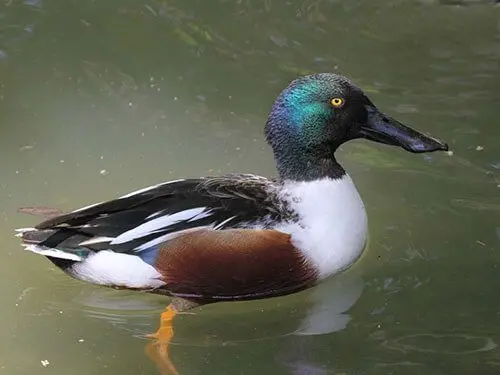
With their large, spatula-shaped bills, Northern Shovelers are unmistakable. Males have a green head, white chest, and rusty sides, while females are mottled brown with a large bill.
Where to Find Them: Northern Shovelers are common in Florida during the winter months, found in shallow lakes, ponds, and wetlands. Merritt Island National Wildlife Refuge is a popular spot for observing these unique ducks.
Ecological Role: Northern Shovelers play a role in filtering and cleaning water. Their large bills are adapted for sifting through mud and water to find food, which helps keep aquatic ecosystems clean and balanced.
Interesting Fact: The Northern Shoveler’s bill is lined with comb-like structures called lamellae, which they use to filter food from the water.
10. Black-bellied Whistling-Duck (Dendrocygna autumnalis)
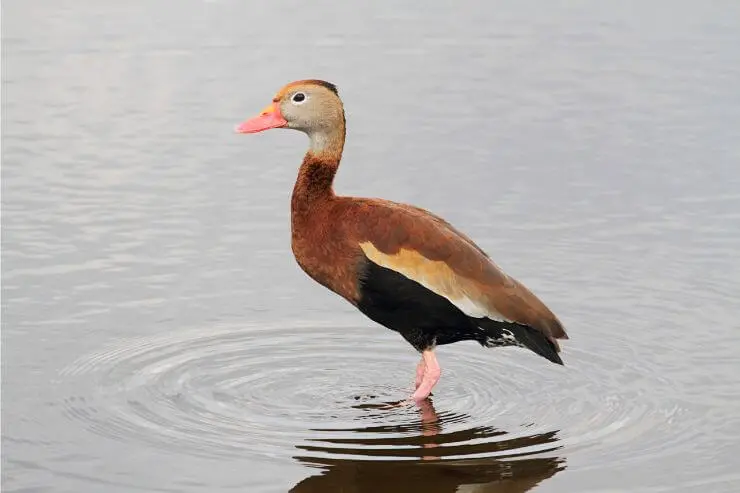
Black-bellied Whistling-Ducks are one of the most distinctive ducks in Florida, known for their long legs, upright posture, and, as their name suggests, a whistling call. They have a striking appearance with their chestnut bodies, black bellies, and pink bills.
Where to Find Them: These ducks are commonly found in Florida throughout the year. They prefer shallow lakes, ponds, and marshes. Corkscrew Swamp Sanctuary is a renowned location for seeing these ducks in the wild.
Ecological Role: Black-bellied Whistling-Ducks are important seed dispersers, feeding on a variety of plant materials and helping to spread seeds throughout their habitats.
Interesting Fact: Unlike most ducks, Black-bellied Whistling-Ducks are often seen perching in trees, thanks to their strong legs and claws.
11. Canvasback (Aythya valisineria)
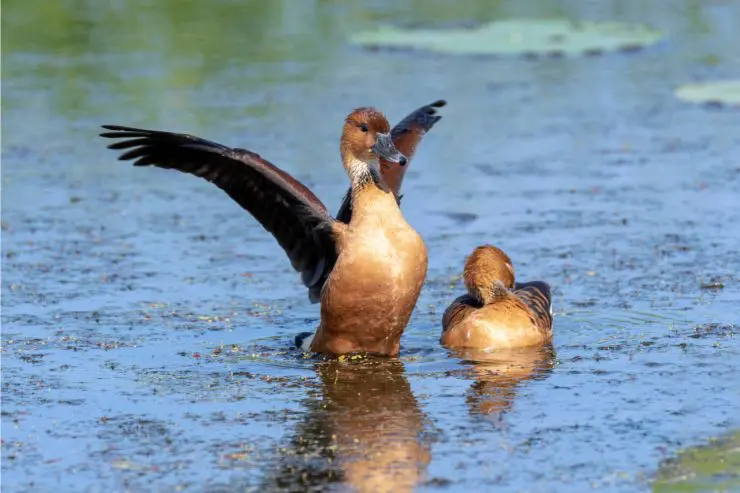
The Canvasback is a large diving duck with a distinctive profile, characterized by its sloping forehead and long neck. Males are easy to identify with their reddish-brown heads, black chests, and white backs, while females have a more subdued brown appearance.
Where to Find Them: Canvasbacks are primarily winter visitors in Florida. They favor large, open bodies of water such as lakes and estuaries. The Loxahatchee National Wildlife Refuge is an excellent spot to observe these ducks during the winter months.
Ecological Role: Canvasbacks are critical to the health of aquatic ecosystems. As diving ducks, they feed on aquatic plants, particularly wild celery, and various invertebrates, contributing to the balance of plant and animal life in their habitats.
Interesting Fact: Canvasbacks are known for their speed and agility in flight, often reaching speeds of up to 70 mph. This makes them one of the fastest flying duck species.
12. Lesser Scaup (Aythya affinis)
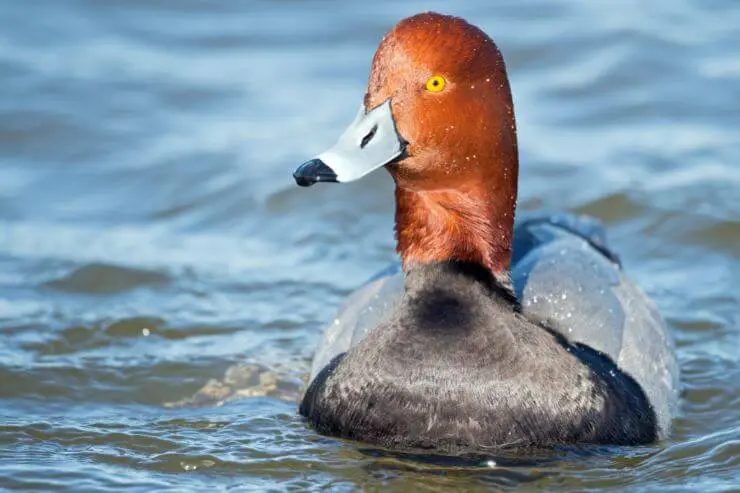
Lesser Scaups are small, diving ducks that are easy to recognize by the iridescent purple sheen on the heads of males and the white patches near their beaks. Females are brown with a white patch around the base of the bill.
Where to Find Them: Lesser Scaups are common winter visitors in Florida, found in freshwater lakes, rivers, and coastal bays. Lake Okeechobee is a well-known location where birdwatchers can observe large flocks of these ducks.
Ecological Role: Lesser Scaups are vital for controlling populations of aquatic insects and other invertebrates, which they consume in large quantities. This helps to maintain the ecological balance of the wetlands they inhabit.
Interesting Fact: Lesser Scaups are often confused with Greater Scaups, but they can be distinguished by their smaller size and subtle differences in head shape and coloration.
13. Hooded Merganser (Lophodytes cucullatus)
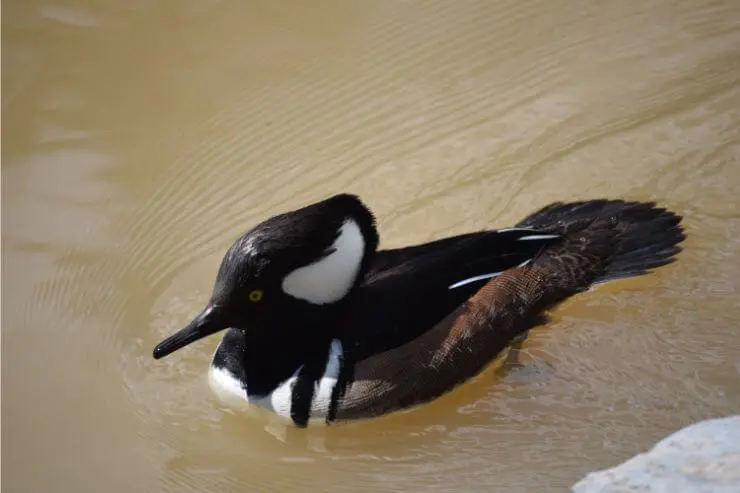
The Hooded Merganser is a small, striking duck known for its fan-shaped crest. Males are particularly eye-catching with their black and white patterns and bright golden eyes, while females have a more subdued brown appearance with a cinnamon-colored crest.
Where to Find Them: Hooded Mergansers are often seen in the freshwater ponds and rivers of Florida during the winter months. The Wakodahatchee Wetlands is a popular location for spotting these elegant ducks.
Ecological Role: Hooded Mergansers are specialized fish eaters, using their serrated bills to catch and hold slippery prey. They play a critical role in controlling fish populations, which helps maintain a healthy balance in aquatic ecosystems.
Interesting Fact: Hooded Mergansers are among the few duck species that have specially adapted eyes, allowing them to see clearly underwater, aiding in their ability to catch fish.
14. Redhead (Aythya americana)
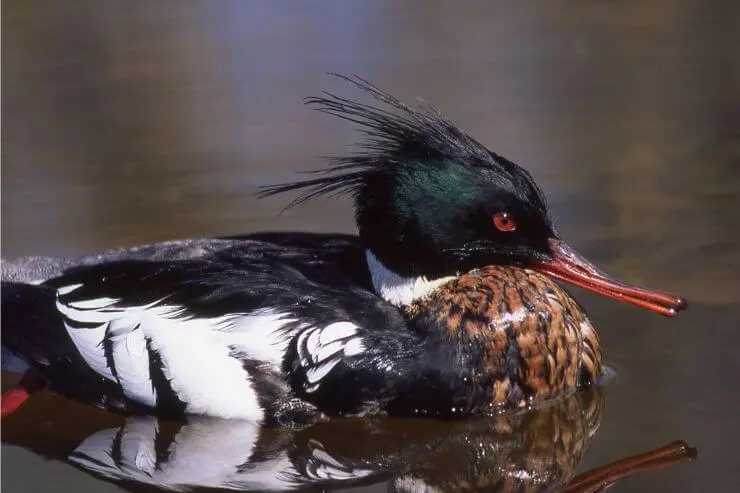
Redheads are medium-sized diving ducks named for the rich reddish-brown heads of the males, contrasted by their blue-grey bills and black chests. Females are more muted, with brown plumage and pale faces.
Where to Find Them: Redheads are winter visitors in Florida, favoring large lakes and coastal bays. They are frequently seen in places like the Merritt Island National Wildlife Refuge, where they gather in large flocks.
Ecological Role: Redheads feed on a variety of aquatic plants and invertebrates, playing a key role in maintaining the health and diversity of wetland ecosystems. Their feeding habits help to control plant growth and invertebrate populations.
Interesting Fact: Redheads are known to occasionally lay their eggs in the nests of other duck species, a behavior known as brood parasitism, which can increase their chances of successful offspring.
15. Bufflehead (Bucephala albeola)
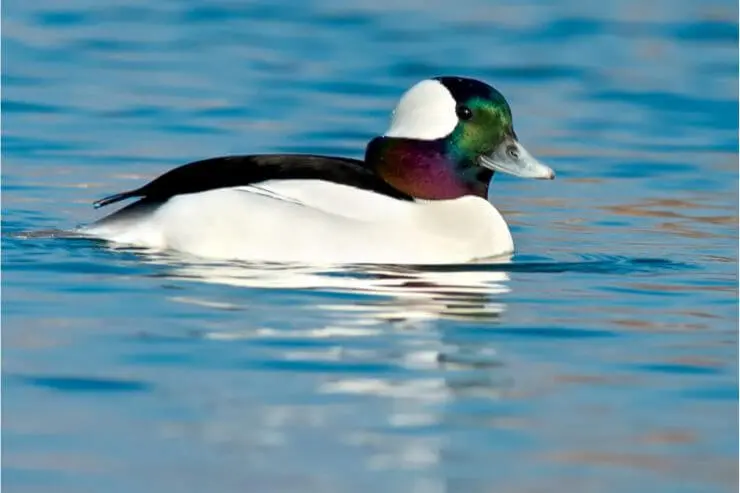
The Bufflehead is one of the smallest diving ducks, easily recognizable by its large, bulbous head and compact body. Males are striking with their black and white plumage and iridescent green and purple heads, while females are more subdued with grey-brown coloring and a distinctive white cheek patch.
Where to Find Them: Buffleheads are winter visitors to Florida, often found in sheltered coastal bays, estuaries, and freshwater lakes. The Sanibel Island area is a popular spot for observing these small, active ducks.
Ecological Role: Buffleheads primarily feed on aquatic invertebrates, which helps control insect populations in their habitats. Their diving behavior also aids in the oxygenation of water bodies, promoting a healthy aquatic environment.
Interesting Fact: Buffleheads are cavity nesters, often using old woodpecker holes for nesting. Their small size allows them to fit into cavities that are too small for larger duck species.
16. Red-breasted Merganser (Mergus serrator)

Red-breasted Mergansers are slender, elegant ducks with a distinctive spiky crest. Males are particularly striking with their green heads, red eyes, and rusty-colored breasts, while females have a more subtle brownish-grey appearance.
Where to Find Them: These ducks are common winter visitors to Florida’s coastal waters, including bays, estuaries, and coastal marshes. The Florida Keys are a prime location to spot Red-breasted Mergansers.
Ecological Role: Like other mergansers, Red-breasted Mergansers are piscivorous, meaning they primarily feed on fish. Their presence helps regulate fish populations, contributing to the balance of marine ecosystems.
Interesting Fact: Red-breasted Mergansers are known for their cooperative hunting behavior, where groups of ducks work together to herd fish into shallower waters for easier capture.
17. Black Scoter (Melanitta americana)

The Black Scoter is a sea duck that is easily identifiable by its entirely black plumage and bright yellow-orange knob at the base of the bill in males. Females are brown with a more subdued appearance.
Where to Find Them: Black Scoters are found along Florida’s coastal waters during the winter months, particularly in the Gulf of Mexico and the Atlantic Ocean. They can often be seen off the coast of Fort Lauderdale and other southeastern coastal areas.
Ecological Role: Black Scoters feed primarily on mollusks and crustaceans, playing a crucial role in maintaining the health of benthic ecosystems by controlling the populations of these species.
Interesting Fact: Black Scoters are one of the most marine-adapted duck species, spending much of their life at sea and coming to shore only to breed.
18. White-winged Scoter (Melanitta deglandi)

The White-winged Scoter is a large, robust sea duck with striking white patches on its wings and a white teardrop shape below its eyes. Males are predominantly black, while females are brown with paler facial markings.
Where to Find Them: These ducks are seen off the coasts of Florida during the winter, particularly in areas with strong surf and rocky shorelines. Look for them around the Panhandle and the northern Gulf Coast.
Ecological Role: White-winged Scoters are important for controlling populations of marine invertebrates, particularly mussels and clams, which they pry off rocks with their strong bills.
Interesting Fact: White-winged Scoters can dive to depths of up to 60 feet in search of food, making them one of the deepest diving duck species.
19. Surf Scoter (Melanitta perspicillata)
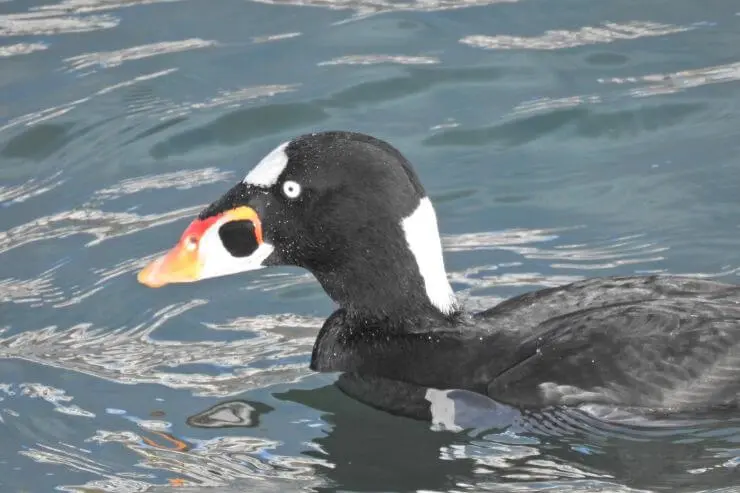
The Surf Scoter is a striking sea duck with a unique appearance. Males have an all-black body with distinctive white patches on the forehead and nape, while females are brown with paler head markings. Both sexes have large, colorful bills.
Where to Find Them: Surf Scoters are found along Florida’s coastal waters in the winter. They prefer turbulent waters, often seen riding the surf near sandy beaches and rocky coastlines.
Ecological Role: Surf Scoters feed on a variety of marine invertebrates, including shellfish and crabs. Their feeding habits help control these populations and contribute to the balance of coastal ecosystems.
Interesting Fact: Surf Scoters are sometimes called “skunk-head coots” due to their distinctive black and white head pattern.
20. Fulvous Whistling-Duck (Dendrocygna bicolor)

The Fulvous Whistling-Duck is a long-legged, slender duck known for its rich fulvous (tawny) plumage and characteristic whistling call. Both males and females share similar appearances, making them easy to identify.
Where to Find Them: These ducks are found year-round in Florida, especially in freshwater wetlands, marshes, and rice fields. The Everglades are a prime location for observing Fulvous Whistling-Ducks.
Ecological Role: Fulvous Whistling-Ducks feed on seeds, grains, and aquatic vegetation, playing a significant role in seed dispersal and the propagation of wetland plants.
Interesting Fact: Fulvous Whistling-Ducks are highly social and often seen in large flocks, especially during the non-breeding season.
Conservation Challenges and Efforts
The variety of duck species in Florida is a testament to the state’s rich biodiversity and the importance of wetland habitats. However, these ecosystems face numerous threats, including habitat loss, pollution, and climate change. Protecting these vital areas is crucial for the survival of Florida’s duck populations and the overall health of the environment.
Habitat Protection: Many organizations, such as the Florida Fish and Wildlife Conservation Commission (FWC) and The Nature Conservancy, are actively working to protect and restore wetland habitats across the state. Conservation easements, protected areas, and habitat restoration projects are essential strategies in these efforts.
Pollution Control: Reducing pollution, particularly from agricultural runoff and industrial sources, is vital for maintaining clean, healthy water bodies that support diverse wildlife. Efforts to regulate and minimize pollutants entering wetlands are ongoing, with stricter enforcement of environmental regulations.
Climate Change Mitigation: Rising sea levels and increasing temperatures pose significant threats to Florida’s wetlands. Conservationists are focusing on strategies to mitigate these effects, including the restoration of mangroves and other coastal vegetation, which can act as natural buffers against storm surges and erosion.
Public Awareness and Education: Engaging the public in conservation efforts is crucial for long-term success. Education programs, citizen science projects, and community involvement in habitat restoration are vital components of these efforts. By raising awareness about the importance of wetland conservation, more people can be encouraged to participate in protecting these critical ecosystems.
Conclusion: Types of Ducks in Florida
Florida’s rich diversity of duck species is a marvel for birdwatchers and nature enthusiasts alike. From the striking plumage of the Wood Duck to the distinctive calls of the Black-bellied Whistling-Duck, each species adds to the vibrant tapestry of the state’s wildlife. Understanding and appreciating these ducks not only enhances our experience of nature but also underscores the importance of conserving the habitats they rely on.
As we continue to face environmental challenges, the role of conservation becomes ever more critical. By protecting the wetlands and other habitats that ducks and countless other species call home, we ensure that future generations will also have the opportunity to enjoy and be inspired by the natural beauty and biodiversity of Florida.
Tips for Birdwatchers
- Bring Binoculars: Ducks can be shy and often keep their distance. A good pair of binoculars will help you observe them without disturbing their natural behavior.
- Visit Early Morning or Late Afternoon: These are the best times to see ducks when they are most active.
- Learn the Calls: Each duck species has a unique call. Familiarizing yourself with these can help you identify ducks even when they are hidden from view.
- Respect Wildlife: Always keep a respectful distance and avoid disturbing the ducks, especially during nesting seasons.
Birdwatching not only offers a chance to observe and appreciate the beauty of ducks and other wildlife but also plays a critical role in conservation. By recording sightings and participating in citizen science projects, birdwatchers contribute valuable data that can help scientists track population trends and monitor the health of ecosystems. Through awareness and action, we can all play a part in preserving the natural wonders of Florida for future generations.
FAQs: Types of Ducks in Florida
What are the most common types of ducks found in Florida?
Florida is home to a variety of duck species, making it a prime location for birdwatching enthusiasts. The most common ducks in Florida include the mottled duck, mallard, wood duck, ring-necked ducks, and the american black duck. Each of these common ducks has unique characteristics that make them stand out in the wetlands and marshes of the Sunshine State.
What is the habitat preference for ducks in Florida?
Ducks in Florida typically inhabit areas near water, such as ponds, lakes, rivers, and marshes. They prefer habitats that offer ample vegetation for cover and foraging, such as reeds and grasses. The marsh ecosystems provide a rich source of food and nesting materials, making them ideal for various duck species. Additionally, wood ducks are often found in wooded swamps and along riverbanks.
How do male and female ducks differ in appearance?
In many duck species, sexual dimorphism is prominent, meaning that male and female ducks have different physical characteristics. For instance, male wood ducks are known for their vibrant plumage, featuring a striking black head and a white stripe along their neck and head and neck. In contrast, female wood ducks typically display more muted colors, primarily light brown with subtle markings. This difference helps males attract potential mates while providing females with camouflage.
What are the identifying features of the mottled duck?
The mottled duck is a native species to Florida, easily identified by its overall brown coloration and distinctive white speculum. They often have a white patch on their wings and a darker black tip on their bills. Unlike other common species like the mallard, the mottled duck lacks the vibrant coloration of males and appears more drab, which helps in blending with their marshy surroundings.

